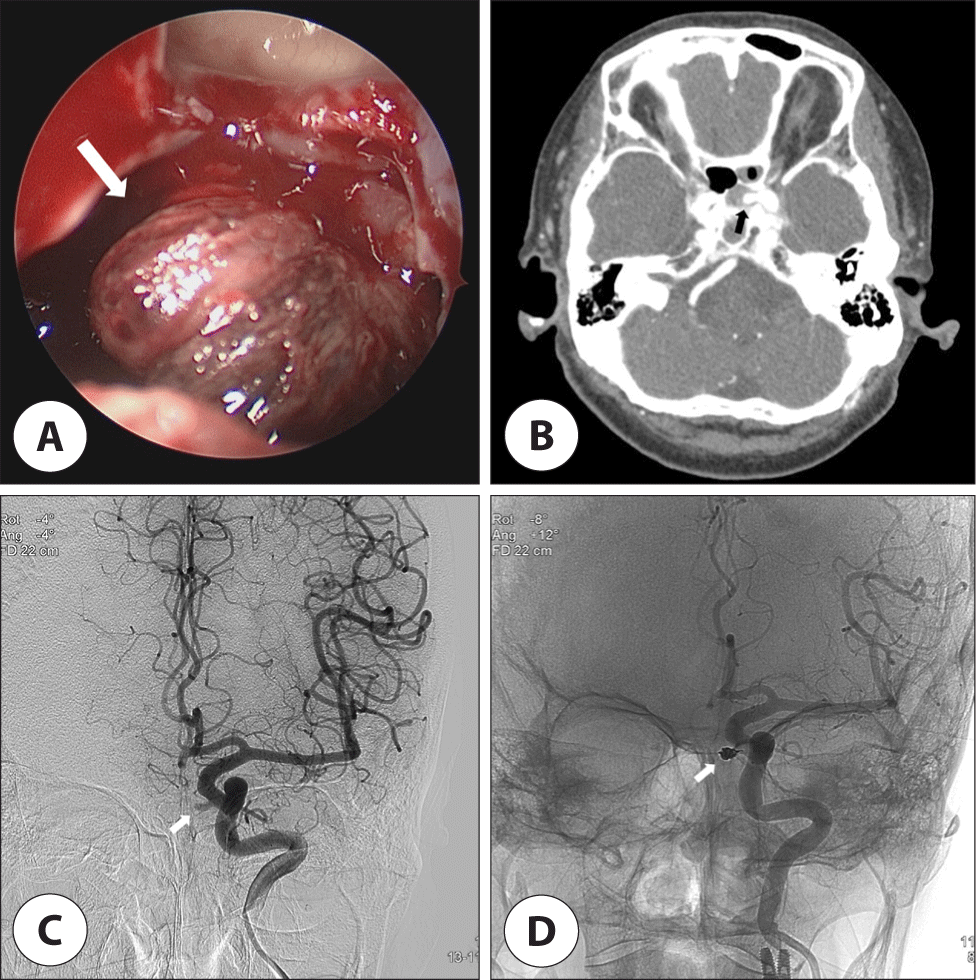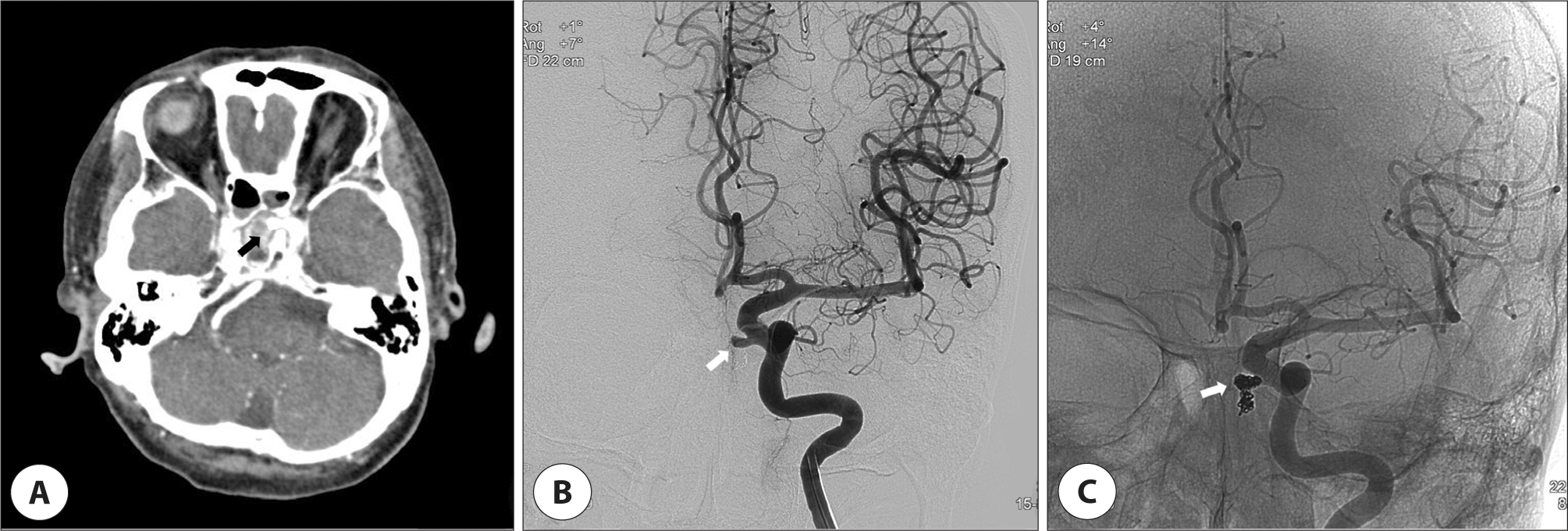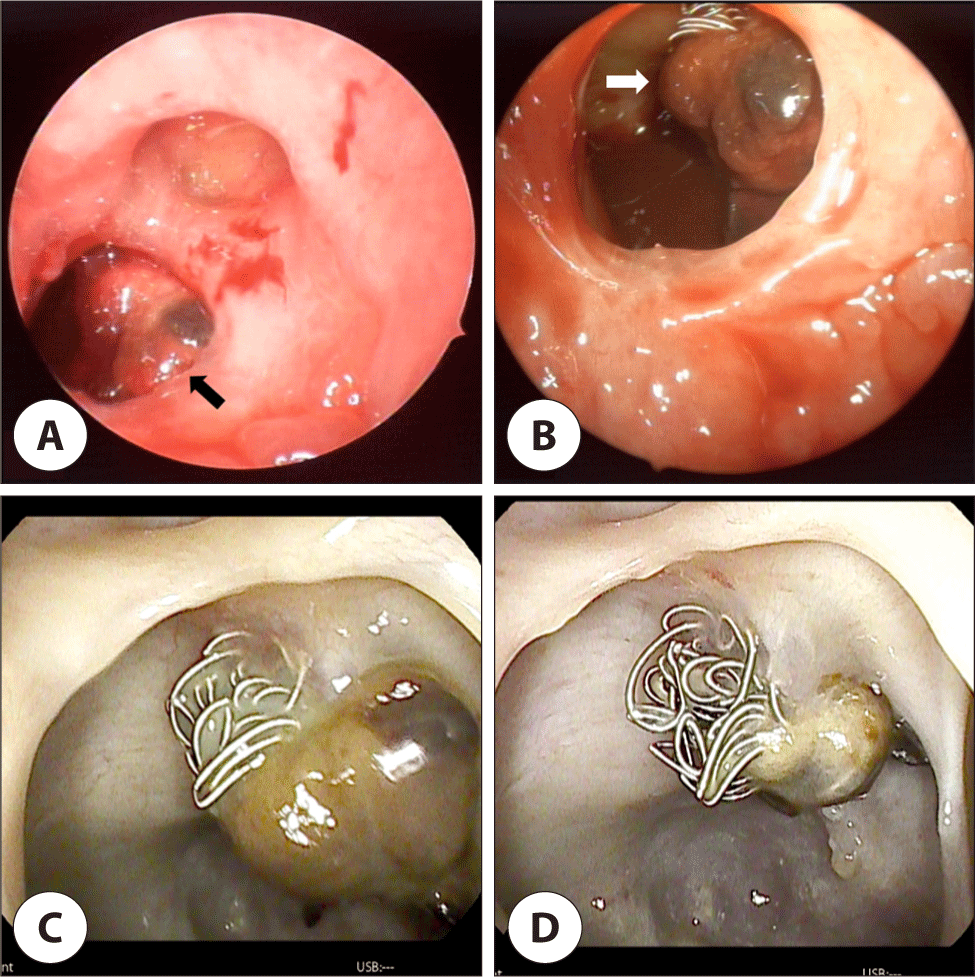Introduction
Epistaxis is one of the otolaryngologic emergencies frequently seen in emergency rooms or primary care.1) Although most epistaxis arises from damage to the nasal mucosa, the other cause, such as intracranial pseudoaneurysm, must always be included in the differential diagnosis.2) Intracranial pseudoaneurysms are extremely rare but can result in fatal outcomes. Intracranial pseudoaneurysms account for approximately 1% of all cerebral aneurysms, with a related mortality rate exceeding 20%.3) The most common cause of pseudoaneurysms is trauma, which can also arise from infections, iatrogenic, or, rarely, spontaneously.3)
Spontaneous intracranial pseudoaneurysms are rare, and if there are no other symptoms beyond epistaxis, they can be challenging to diagnose.4,5) An untreated pseudoaneurysm can result in a mortality rate exceeding 50%. Thus, a delayed diagnosis and treatment of spontaneous pseudoaneurysm can result in lethal outcomes. The primary treatment for intracranial pseudoaneurysms is coil embolization, performed with angiography, and it shows good treatment results.3)
We have experienced a case where repeated epistaxis occurred in a patient without a history of trauma or infection, and there were difficulties in diagnosing a pseudoaneurysm, which required two endovascular treatments.
Case Report
An 83-year-old female patient visited the emergency room due to left-sided epistaxis. She had been treated for repeated left-sided epistaxis at a local clinic, which began two weeks before her visit. She was transferred to our hospital as the recurrent symptoms and deviation of the nasal septum made it challenging to confirm the posterior nasal cavity. When the patient arrived at the emergency room, there was no epistaxis. She had hypertension and was taking medication, but she had no other underlying diseases and no history of trauma or surgery to the head and neck. Considering the possibility of bleeding from the posterior nasal cavity, we performed an endoscopic exploration in the operating room. After local anesthesia of nasal cavity and vasoconstriction of the nasal mucosa by bosmin-soaked pledget, it was possible to inspect the posterior nasal cavity. No specific focus of bleeding was in the nasal cavity, so septoplasty was not performed and we decided to admit her for close observation. She was discharged after one week of hospitalization without recurrence of symptoms.
Three weeks after discharge, she revisited the emergency room due to recurrent left-sided epistaxis. We headed to the operating room to identify and control the bleeding site. Under local anesthesia, during nasal endoscopy, we noticed blood flowing from the left sphenoethmoidal recess. Suspecting bleeding inside the sphenoid sinus, we performed an endoscopic sinus surgery to inspect the sinus. We found the entrance of the sphenoid sinus blocked by a thrombus and noticed faint pulsating bleeding. After carefully removing the anterior wall of the sphenoid sinus, we found a pulsating mass protruding from the lateral sidewall of the sphenoid sinus with minimal bleeding (Fig. 1A). We suspected an internal carotid artery aneurysm, packed the nasal cavity and sinus with Vaseline gauze, ended the operation, and immediately performed a brain computed tomography angiogram (CTA).

The brain CTA revealed a pseudoaneurysm of the left internal carotid artery, and we planned angiography and endovascular treatment (Fig. 1B). However, the following morning, the patient experienced massive epistaxis while asleep. We controlled the bleeding with additional vaseline gauze packing in the nasal cavity and immediately performed an emergency angiography. After confirming the pseudoaneurysm on angiography, the radiologist performed coiling embolization (Fig. 1C, D). On the fifth day after treatment, we performed a follow-up brain CTA, which did not show signs of recurrence. However, we noticed minor bleeding and inspected the sphenoid sinus using a nasal endoscope. It was filled with a blood clot, but no active bleeding was observed. After inspection, we packed the nasal cavity with Vaseline gauze again and decided to monitor her condition.
Minor nosebleeds occurred several times after treatment but were easily controlled. However, massive epistaxis occurred again in the third week after treatment. After consulting with a radiologist, we performed brain magnetic resonance angiography (MRA) and left internal carotid artery angiography. The tests suspected a small recurrent sac at the previous aneurysm site, but it was small, and the bleeding had stopped, so we decided to observe the patient’s condition closely. Two days later, left-sided epistaxis recurred, and we performed a brain CTA (Fig. 2A). It showed a recurrent aneurysm sac and hemorrhage inside the sphenoid sinus at the previous coiling site. Therefore, we performed an emergency angiography under general anesthesia. The angiogram revealed a recurrent aneurysm, so the radiologist performed stent-assisted coil embolization (Fig. 2B, C).

The patient was hospitalized for two weeks for observation after the second endovascular treatment and was discharged without recurrence of nasal bleeding. In the third week after the second treatment, there was an aneurysm sac in the sphenoid sinus but no signs of bleeding (Fig. 3A). Nasal endoscopy confirmed coil exposure from the sac in the fourth week after the second treatment (Fig. 3B). In the sixth week, as the sac decreased, more coil was exposed, and in the eighth week, the aneurysmal sac in the sphenoid sinus was almost gone, and most of the coil was exposed (Fig. 3C, D). There was no nosebleed until the last follow-up.

Discussion
This report presented a case of spontaneous intracranial pseudoaneurysm in a patient with hypertension and atherosclerosis. Intracranial pseudoaneurysm is a rare disease often associated with a history of trauma, infection, or surgery.3,6) While epistaxis is a primary symptom of intracranial pseudoaneurysm, it is also common in other cases.1) This patient had no history of trauma, infection, or surgery and no other symptoms besides epistaxis. So, it was difficult to suspect a pseudoaneurysm, thus delaying the diagnosis.
Spontaneous occurrence of intracranial pseudoaneurysm is very rarely reported. Reported causes include Marfan's syndrome, fibromuscular dysplasia, vasculitis, rupture of true cerebral aneurysm, arteriovenous malformation, moyamoya disease, radiotherapy, and atherosclerosis.3,4,7) This patient had been taking medication for hypertension, and signs of atherosclerosis in the major vessels were observed, which can be hypothesized as the cause. However, hypertension and atherosclerosis are too common in older people to be useful diagnostic information.
For diagnosing pseudoaneurysms, a radiological examination is usually required. CTA and MRA are good methods that can help diagnose, but digital subtraction angiography (DSA) is the gold standard for diagnosing pseudoaneurysm.3,6) The advantage of DSA is that it allows for attempted treatment at the same time as diagnosis. However, there is still controversy over whether to repeat the test if it is negative or when to perform a follow-up examination after treatment.
Treatment of pseudoaneurysms varies depending on the patient's condition, the location of the aneurysm, and the anatomical structure of the blood vessels. Good results have recently been reported with endovascular treatment, but microsurgery may be needed if the treatment fails.6) In rare cases, conservative treatment alone is performed when a pseudoaneurysm is discovered. In this case, we attempted treatment with coil embolization, and the procedure was successful, but we had to perform stent-assisted coil embolization again due to recurrence.3) The course between the first and second treatments provides a good lesson. Even if the procedure is successfully completed, the possibility of recurrence should always be kept in mind, and it should be remembered that the recurrence of the disease cannot be fully known through radiological examination alone. It is essential to examine the patient's symptoms and overall condition carefully, and an active approach can prevent potentially fatal results when abnormalities are detected.
This case provides a valuable point of spontaneous intracranial pseudoaneurysm, contributing to an academic understanding of this rare disease. In this case, the difficulties we experienced in the diagnosis and treatment process will raise awareness of this disease and help prepare in advance. However, this case has several limitations. The treatment methods used in this case were not novel, and long-term follow-up observation was difficult due to the patient's circumstances. As a result, we were unable to confirm the condition of the exposed coil. However, through this case, our understanding of the diagnosis and treatment of pseudoaneurysms was further expanded, and it emphasized the importance of thorough monitoring of the potential dangers of pseudoaneurysms.
In conclusion, spontaneous intracranial pseudoaneurysm is a rare disease, and it can be difficult to distinguish from simple epistaxis if there are no other symptoms early in the condition. Even if You think simple epistaxis, repeated occurrence requires suspicion of rare causes, which can help prevent fatal outcomes of pseudoaneurysms. Even if a procedure for treatment has been successfully performed, vigilance for recurrence should not be relaxed for a certain period, and diagnosis through patient symptoms and physical examination should be addressed, relying solely on imaging examinations.






